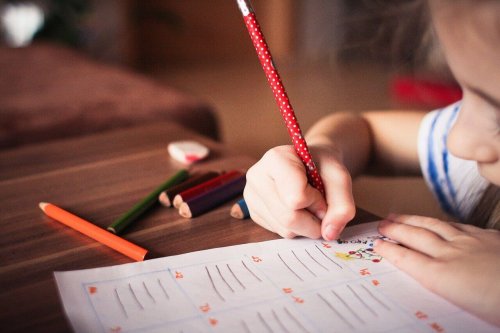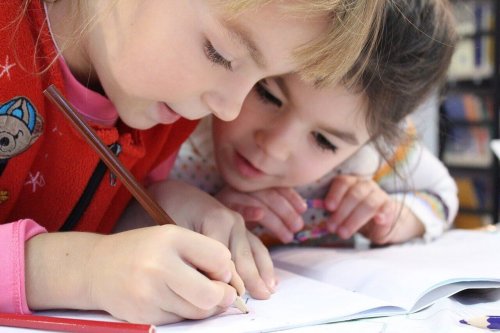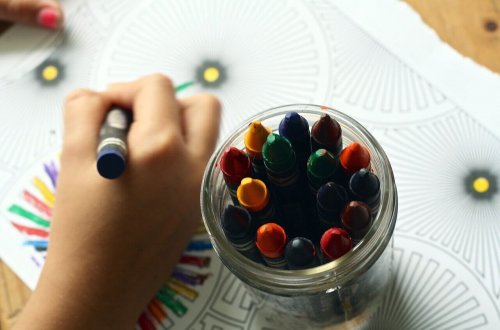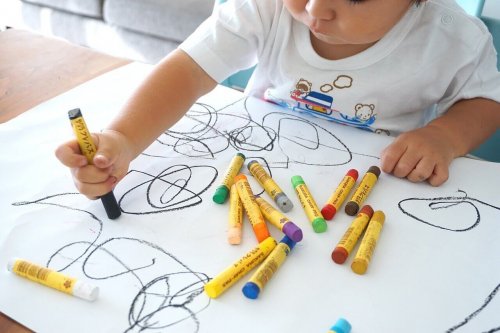Eight Benefits of Drawing for Children

There are many benefits of drawing for children. After all, it’s an ideal way to develop motor and mental skills. It also strengthens their exploratory, psychological, and emotional development.
Unlike adults, children don’t worry about what others think. They’re not prejudiced against their drawings, and they have no emotional or mental barriers when they draw.
A child can make magic with a few crayons, colored pencils and paper. Sometimes, they just scribble. Other times, you see how much potential they have when you see their remarkable pieces of art.
In this article, we’ll take a look at the many amazing benefits of drawing for children.
Small Strokes, Great Benefits of Drawing for Children

Drawing allows children to strengthen both the rational left side of their brain and the emotional and creative traits that correspond to the right side. Plus, they also enjoy doing so. As with games and playing, a child feels the pleasure of the movement that drawing requires.
Drawing is a great skill that we all should encourage in children from the moment they can hold a crayon. Here are some of the many benefits that drawing brings to children.
1. Drawing Encourages Imagination and Creativity
Children are not aware that words are written with specific symbols on paper. This is why they’re often fascinated when they look at storybooks full of colors and drawings – it’s the language they understand.
When your child begins to draw, it stimulates their imagination. By putting strokes on a sheet, they begin to symbolize characters and objects that they choose from their surroundings. They also begin to verbalize what they do and why they do it.
Children use their drawings as support for incredible and fantastic stories that are the product of their imagination.
Take the opportunity to explore your child’s world. Ask them to show you their drawings. You’ll be surprised by their boldness and inventiveness.
It might interest you: 5 Children’s Books Your Child Should Read Before They Turn 6
2. They Help Develop Brain-Hand-Eye Coordination

A child’s first strokes may not make sense to us. This is because the child doesn’t have coordination between their brain, their eyes, and their hand. Therefore their drawings will lack order and meaning and will extend outside the sheet of paper.
Allow children to hold crayons any way they feel comfortable. After all, they’re still experimenting. They may put a lot of pressure with their hand and will make strokes by moving arm and shoulder. Sometimes, they may also move their entire body as if they were dancing with the crayon.
Little by little, the child is perfecting their drawing technique. They’re starting to discover that the movements they make are related to the lines they’re putting on paper.
That’s why drawing is great for developing fine motor skills, as it involves moving every bone in the fingers. This will facilitate their ability to write later on.
3. It’s a Way to Measure the Child’s Growth

There are milestones when it comes to drawing; they’re similar to the stages of child development.
- The beginning is always chaotic and the child, seemingly, has no control over their strokes.
- Then, after about 18 months, their strokes are cleaner. This lasts for up to third or fourth birthday.
- Then, they begin to do pre-schematic drawings until the age of 6. This is the stage of stick figures (a circle that represents the head and two vertical lines that represent the legs).
4. Drawing Stimulates Concentration and Promotes Careful Observation
Among the many benefits of drawing in children, there’s also the incentive to concentrate and persevere. This is where drawing helps them organize their ideas and the perception of what’s around them. After all, children mainly draw about what they know.
Drawing stimulates a child’s sense of observation. The brain works harder in this process to try to abstract reality on a piece of paper. Further, this exercise promotes the development of visual perception and abstract thinking.
5. It Encourages Emotional Intelligence
Coloring and painting favor the emotional intelligence of children since these learn to identify emotions and later express them on paper using color.
Among the benefits of drawing in children, this is what most reinforces their mental health. This activity relaxes them and helps them forget about the complicated situations they perceive around them. It allows them to do something fun and enjoy themselves.
When children begin to master a graphic layout, they mature psychologically, emotionally, and physically. It definitely contributes to the formation of their personality.
Read more: 10 Values You Must Teach Your Children
6. It Strengthens Their Self-Esteem
Drawing, painting, and coloring all strengthen a child’s self-esteem. Children want to stand out with their artistic prowess. It brings them joy and satisfaction. They feel they’re doing something important.
When a child shows you a drawing, they do so with great pride. To them, it’s historic, and it also is for their development. It’s important to encourage and applaud the creative work of children.
Show interest in what they do. Drawing is one of the first forms of communication and expression. They are exploring a new language.
Pay attention to what they’re saying through their drawings. you’ll be surprised how much you can learn about your child when you learn how to understand their work.
7. It Develops Sensitivity

Through art, children build bridges between their feelings and their knowledge. Therefore, one of the benefits of drawing is that your child is modifying the world around him or her and his or her experience of it by capturing an image on paper.
Also, drawing gives the child an opportunity to create, recreate, and develop their sensitivity. Similarly, thanks to the expressive ability of each stroke, a child will be more willing to learn.
8. It Unites the Family
As if all of the above wasn’t enough, drawing also strengthens family ties. Drawing together with one’s parents or siblings is also a way to stimulate affection and connection.
Take advantage of every chance you have to draw along with your child. They’ll be delighted to have their mom, dad, and everyone else they like joining their party!
To Enhance the Benefits of Drawing in Children
Despite the many benefits of drawing for children, make sure to never force your child to draw if it isn’t what they want to do at a given moment. You can try to get them interested in it. However, do so without forcing the situation. Also, respect their pace.
Drawing is an activity that a child should fully enjoy. Let them choose their colors and the subjects they wish to explore.
In addition, give them space and creative freedom. Then, let them explain what they’re doing. Besides listening to their inborn-philosopher explanations, you’ll also stimulate their language development.
Finally, always praise your child for any efforts they make. Then, you’ll see how their self-confidence grows and how they strengthen their creative skills.
All cited sources were thoroughly reviewed by our team to ensure their quality, reliability, currency, and validity. The bibliography of this article was considered reliable and of academic or scientific accuracy.
- Soriano De La Cruz, K. M., & Zúñiga Villao, E. P. (2019). Expresión artística en el desarrollo de la imaginación de niños de 4 años (Bachelor’s thesis, Universidad de Guayaquil. Facultad de Filosofía, Letras y Ciencias de la Educación.). http://repositorio.ug.edu.ec/handle/redug/42457
- Chablay Fonseca, A. B. (2017). El dibujo creativo en el desarrollo de la coordinación visomotriz de niños y niñas de 4 a 5 años de edad de la Unidad Educativa Liceo Oxford del cantón Salcedo de la provincia de Cotopaxi (Bachelor’s thesis, Universidad Técnica de Ambato. Facultad de Ciencias Humanas y de la Educación. Carrera de Parvularia). https://repositorio.uta.edu.ec/handle/123456789/25917
- Muños-Hidalgo, M. D. (2014). El dibujo infantil: La etapa preesquemática. http://tauja.ujaen.es/handle/10953.1/796
- Alarcón Gallego, E. C., & Guzmán Grijalva, M. L. (2017). Potenciar la atención y concentración de los estudiantes de grado 2 de la escuela Isabel de castilla a través de actividades artísticas y lúdico-pedagógicas. https://repository.libertadores.edu.co/handle/11371/1112
- Torres Monge, L. (2016). Inteligencia emocional, autoconcepto y autoestima a través de la educación plástica. https://uvadoc.uva.es/handle/10324/21404
- Fernández, E. R. (2007). Aplicaciones del Arteterapia en aula como medio de prevención para el desarrollo de la autoestima y el fomento de las relaciones sociales positivas:” Me siento vivo y convivo”/” Art Therapy applications in the classroom as a preventive measure using artistic manifestations for the self esteem development and the fostering of positive social relationships:” I FEEL ALIVE AND CO LIVE”. Arteterapia, 2, 275. https://revistas.ucm.es/index.php/ARTE/article/view/ARTE0707110275A
This text is provided for informational purposes only and does not replace consultation with a professional. If in doubt, consult your specialist.








